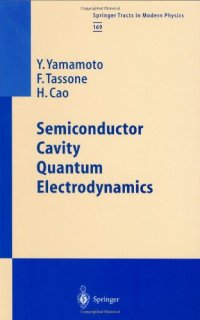
Ebook: Lectures on Ultrafast Intense Laser Science 1: Volume 1
- Tags: Optics Optoelectronics Plasmonics and Optical Devices, Atomic/Molecular Structure and Spectra, Biophysics and Biological Physics, Physical Chemistry, Laser Technology Photonics, Quantum Optics
- Series: Springer Series in Chemical Physics 94
- Year: 2011
- Publisher: Springer-Verlag Berlin Heidelberg
- City: Berlin ; London
- Edition: 1
- Language: English
- pdf
This book features tutorial-like chapters on ultrafast intense laser science by world-leading scientists who are active in the rapidly developing interdisciplinary research field. It is written to give a comprehensive survey of all the essential aspects of ultrafast intense laser science. The volume covers theories of atoms and molecules in intense laser fields, high intensity physics scaled to long wavelength, pulse shaping techniques, non-linear optics in the XUV region, ultrafast X-ray spectroscopy, quantum emission and applications, filamentation, and ultraintense-laser matter interaction.
This monograph is the first to give a comprehensive account of the theory of semiconductor cavity quantum electrodynamics for such systems in the weak-coupling and strong-coupling regimes. It presents the important concepts, together with relevant, recent experimental results Note continued: 3.3.4. Wavelength Scaling of the Photoelectron Spectra -- 3.3.5. Wavelength Scaling of the Ionization Rate: TDSE vs. Tunneling Theory -- 3.3.6. Intensity Scaling of the Rescattering Plateau -- 3.3.7. Wavelength Scaling of the Rescattering Plateau -- 3.3.8. Ionization of Scaled Systems -- 3.3.9. Low Energy Structure in the Photoelectron Energy Spectra -- 3.4. MIR High Harmonics and Attophysics -- 3.4.1. Scaling of the Harmonic Cutoff -- 3.4.2. Scaling of the Group Delay Dispersion -- 3.4.3. Scaling of the Harmonic Yield -- 3.5. Tomographic Reconstruction of Molecular Orbitals -- References -- 4. How Do Molecules Behave in Intense Laser Fields? Theoretical Aspects / Hirohiko Kono -- 4.1. Introduction -- 4.2. Electronic and Vibrational Dynamics of H+2 in a Near-IR Field -- 4.3. Time-Dependent Adiabatic State Approach and Its Application to Large Amplitude Vibrational Motion of C60 Induced by Near-IR Fields -- 4.4. Bond Dissociation Dynamics of Ethanol: Branching Ratio of C-C and C-O Dissociation -- References -- 5. Pulse Shaping of Femtosecond Laser Pulses and Its Application of Molecule Control / Fumihiko Kannari -- 5.1. Introduction -- 5.2. Femtosecond Laser Pulse Shaping with a 4f Pulse Shaper -- 5.3. Spatiotemporal Coupling at 4f Pulse Shapers -- 5.4. Replica Pulse Formation with a Pixelated SLM Pulse Shaper -- 5.5. Femtosecond Laser Pulse Shaping with an AOPDF -- 5.6. How to Generate the Desired Ultrashort Laser Pulse in an Actual Laser System: Case 1: We Know the Desired Pulse Shape -- 5.7. How to Generate the Desired Ultrashort Laser Pulse in an Actual Laser System: Case 2: We Do Not Know What the Desired Pulse Shape Is -- 5.8. Adaptive Pulse Shaping for Dissociative Ionization of Ethanol Molecules -- 5.9. Adaptive Pulse Shaping of Two-Photon Excited Fluorescence Efficiency -- References -- Note continued: 6. Nonlinear Interaction of Strong XUV Fields with Atoms and Molecules / Katsumi Midorikawa -- 6.1. Introduction -- 6.2. Generation of High-Power High-Order Harmonics -- 6.3. Spatial Properties of High-Order Harmonics -- 6.4. Characterization of Attosecond Pulses by PANTHER -- 6.5. Autocorrelation Measurement of Attosecond Pulses by Molecular Coulomb Explosion -- 6.6. Summary -- References -- 7. Ultrafast X-Ray Absorption Spectroscopy Using Femtosecond Laser-Driven X-Rays / Hidetoshi Nakano -- 7.1. Introduction -- 7.2. Soft X-Ray Emission from Femtosecond Laser-Produced Plasma -- 7.3. Time-Resolved XAFS Measurement of Optically Excited Silicon -- 7.4. Spatiotemporally Resolved XAS -- 7.5. Summary -- References -- 8. Quantum Emission and Its Application to Materials Dynamics / Kazutaka G. Nakamura -- 8.1. Introduction -- 8.2. Quantum Emission -- 8.3. Time-Resolved Imaging with Quantum Emission -- 8.4. Time-Resolved X-Ray Diffraction -- 8.5. Summary -- References -- 9. Filamentation Nonlinear Optics / See Leang Chin -- 9.1. Introduction -- 9.2. Self-Focusing and Filamentation Physics -- 9.3. Theoretical Model and Simulation -- 9.4. Background or Energy Reservoir -- 9.5. Extraordinary Properties of Filaments -- 9.6. Long-Distance Propagation in Air -- 9.7. Clean Fluorescence -- 9.8. Self-Pulse Compression -- 9.9. Self-Spatial Filtering -- 9.10. Self-Group Phase Locking -- 9.11. Nonlinear Optics Inside the Filament Core -- 9.12. Four-Wave Mixing Inside the Filament Core -- 9.13. Detection of Chemical and Biological Agents in Air Based on Clean Fluorescence -- 9.13.1. Halocarbons -- 9.13.2. CH4 -- 9.13.3. Ethanol Vapor -- 9.13.4. CH4 in air -- 9.13.5. Bio-agents: Egg White and Yeast Powders -- 9.13.6. Summary of Remote Sensing Feasibility Using Only One Laser -- Note continued: 9.14. Super-Excited States of Molecules Inside a Filament -- 9.15. Looking Ahead and Conclusion -- References -- 10. Diagnosing Intense and Ultra-intense Laser-Matter Interactions: Status and Future Requirements / Leonida A. Gizzi -- 10.1. Introduction on Ultra-Intense Laser-Matter Interactions -- 10.2. Optical Interferometry and Propagation Issues -- 10.3. Time-Resolved X-Ray Spectroscopy and Imaging -- 10.4. Fast Electron Production and Characterization -- 10.5. Summary and Future Instrumentation Requirements -- References
Download the book Lectures on Ultrafast Intense Laser Science 1: Volume 1 for free or read online
Continue reading on any device:

Last viewed books
Related books
{related-news}
Comments (0)